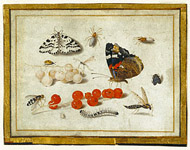 |
 |
 |
 |
Grades/Level: High School (9–12)
Subjects: Visual Arts, Science
Time Required: 3–5–Part Lesson
3–4 class periods
Author: J. Paul Getty Museum Education Staff
Permissions: 
The lesson plan and downloadable materials on this page are licensed under a Creative Commons Attribution 4.0 International License. |
 |
|
 |
 |
 |
 |
 |
 |
 |
Lesson Overview |
 |
Students study insects depicted in a seventeenth-century drawing. They research winged insects, identifying unique characteristics and those common to all insects. Students closely observe winged insects and create detailed drawings of wings. |
 |
 |
 |
 |
 |
Learning Objectives |
 |
Students will:
• Use observation, research, and prior knowledge to describe characteristics shared by all insects.
• Use knowledge about insect anatomy to differentiate among various species of insects represented in a seventeenth-century drawing.
• Understand that insects are invertebrates with exoskeletons.
• Draw insects using a variety of shapes, lines, and textures.
• Use value to create the illusion of three-dimensionality in drawings.
|
 |
 |
 |
 |
 |
 |
 |
 |
 |
Materials |
 |
• Materials listed in the intermediate-level lesson
• Winged-insect specimens
• Tweezers
• Scalpels
• Magnifying glasses
|
 |
 |
 |
 |
 |
|
|
 |
 |
 |
 |
 |
Lesson Steps |
 |
1. Complete steps 1–4 of the beginning-level lesson, adapting for grade level as appropriate.
2. Complete steps 2–7 of the intermediate-level lesson, adapting the steps to focus only on the winged insects depicted in Jan van Kessel's drawing.
3. Introduce the terms invertebrate and vertebrate to students. List types of animals that fall into each category.
4. Once you have identified insects as invertebrates, ask students to speculate about how insects move and keep their shapes without internal bones. Discuss exoskeletons and their functions. Explain that wings are part of the exoskeleton.
5. Hand out specimens of houseflies, butterflies, dragonflies, moths, wasps, or any other winged insect that is represented in Van Kessel's drawing.
6. Have students use tweezers and scalpels to detach the insects' wings from the points at which they join the body. Using magnifying glasses and colored pencils, students will draw diagrams of wings, including as much detail as possible. Students should use line, shape, and color to visually describe the various textures of the wings. On the same page as the drawing, have students write a paragraph describing the wings to someone who cannot see them.
7. Instruct students to work with a partner to compare and contrast their drawings of insect wings with the wings depicted in Van Kessel's drawing. Students should speculate about how various characteristics of wings could allow different insects to move in distinct ways. Have student pairs share their speculations with the entire class.
|
 |
 |
 |
| Butterflies, Insects, Currants, Jan van Kessel, 1650–1655 |
 |
|
 |
 |
 |
 |
 |
 |
 |
Standards Addressed |
 |
Common Core Standards for English Language Arts
Grades 6–12
READING
Key Ideas and Details
1. Read closely to determine what the text says explicitly and to make logical inferences from it; cite specific textual evidence when writing or speaking to support conclusions drawn from the text.
WRITING
Production and Distribution of Writing
4. Produce clear and coherent writing in which the development, organization, and style are appropriate to task, purpose, and audience.
Research to Build and Present Knowledge
7. Conduct short as well as more sustained research projects based on focused questions, demonstrating understanding of the subject under investigation.
8. Gather relevant information from multiple print and digital sources, assess the credibility and accuracy of each source, and integrate the information while avoiding plagiarism.
For more national and California state standards for this curriculum, refer to the charts found in the links at the top right of this page. |
 |

|
 |
 |
 |




